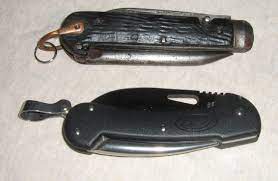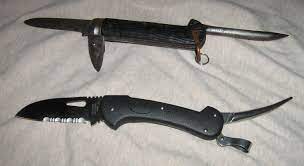
Top: Westby 6353/1905 clasp knife
Bottom: Myerchin L300P Light Knife
 Top: Westby 6353/1905 clasp knife Bottom: Myerchin L300P Light Knife |
Knife technology has changed dramatically in the last century. As such, the sailing knife has gone through a great metamorphosis. The first dramatic change was probably the use of synthetic materials for knife handles. This was soon followed by the introduction of Stainless Steel. As Stainless steel evolved, newer grades and alloys of steels as well as other metals, notably aluminum and titanium were introduced in making of sailing knives.
And while the basic design concept of the folding sailing knife remained the same, an evolving thought process went into the overall concept of how the knife should work. For instance earlier knives almost always required both hands to open and close the blade or marlin spike. Most often, they used a slip joint design which meant the blade and spike would not lock in place. Later the spike locked in place but the blade did not. Still later some knives allowed both the blade and spike to lock yet it still required both hands to open and close the implements. Today, some of the best sailing knives allow one hand operation for both spike and blade. For many of today's sailors, these are really the only sailing knife worth using. However, many of the old patterns remain quite popular among collectors and active sailors alike.
I will admit that I have an affection for many of the older pattern sailing knives. If you look at my collection that will become evident. However, if you're looking for a reliable sailing knife that is easy to operate with one hand, then the older patterns are not going to be a good choice. The evolution of the sailing was driven by the needs of the sailors who use them. When the storm is raging and the waves are tossing you about, the last thing you're going to want to do is let go with both hands in order to open a folding knife. This is why almost all true sailors rely on a fixed blade or a one-hand opening folder as their primary knives. The older two handed folders hang around for menial chores, calm seas, and the yacht club.
See also: my page Comparing Knives found in the section: My Nautical Knives.
 |
|
|
Top: Westby 6353/1905 clasp knife Turn of the 19th/20th century rigging knife made for the British Army and Royal Navy around the time of World War. 1095 carbon steel, construction with a copper bail and jigged wood handles. It has a spear point blade, large marlin spike and triangular shapped can opener. The implements do not lock. It requires both hands to open all implements. Made in Sheffield, England |
Bottom: Myerchin L300P Light Knife Turn of the 20th/21st century rigging knife made for the United States Coast Guard and the Civilian Market approximately 100 years later than the Westby Clasp knife. 440C Stainless steel construction and Zytel handles It has a modified, serrated sheepfoot blade with integrated shackle key, marlin spike, and LED flashlight. The implements lock in the open position The blade and spike can be opened one handed. Made in Seki City, Japan |
This site was updated in March 2014. Primary changes involved correcting grammar, spelling, and removing inaccurate or out of date information.